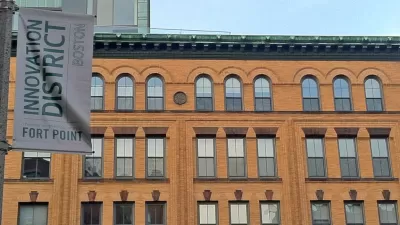In many places, anchor institutions and local industries are old news. New companies, new ideas, and brand-new industries are creating wealth and vibrancy. Professor Enrico Moretti explains how cities can get in on the 'innovation economy.'

Urban areas like Silicon Valley, Austin, Seattle, and Boston have built their contemporary economies on innovation: new ideas that turn into companies that change the world in ways large and small. These companies are the General Motors and IBM's of the 21st century. They are, by and large, creatures of cities.
How, then, do cities build innovation economies?
Enrico Moretti, professor of economics at the University of California-Berkeley, has taken the amorphous idea of innovation and defined it, mapped it, and analyzed its impact on urban economies and workforces. He has found, among other conclusions, that rising tides lift all boats: though generous salaries at innovative firms may raise the cost of living in areas like Palo Alto, they also correspond with rising salaries of people who do not work in innovation. They also correspond with a widening gap between cities that have innovation economies and those that don't.
Urban landscapes are conductive to innovation, but no particular city has an inherent advantage. The growth of innovation depends as much on happenstance as on policy -- but that doesn't mean that cities can't try to create fertile ground.
"All (innovative industries) have two things in common. The first is they tend to employ workers with a high level of human capital, which I measure in terms of education. These are sectors where the number of workers with a college degree is very high. The second is, they make a product or service that is unique: it’s innovative in the sense that it cannot be easily reproduced and easily outsourced."
"It is absolutely true that you see innovation hubs in places that are urban and dense as well as in places that are sprawling and suburban. What you see in both places is a tendency towards urbanism and densification. A lot of the Silicon Valley companies that have offices in the suburban part of the Bay Area have opened offices in San Francisco in great part because their workers prefer living in San Francisco."
FULL STORY: California Cities and the Innovation Economy: Q&A With Enrico Moretti

Alabama: Trump Terminates Settlements for Black Communities Harmed By Raw Sewage
Trump deemed the landmark civil rights agreement “illegal DEI and environmental justice policy.”

Planetizen Federal Action Tracker
A weekly monitor of how Trump’s orders and actions are impacting planners and planning in America.

How Atlanta Built 7,000 Housing Units in 3 Years
The city’s comprehensive, neighborhood-focused housing strategy focuses on identifying properties and land that can be repurposed for housing and encouraging development in underserved neighborhoods.

In Both Crashes and Crime, Public Transportation is Far Safer than Driving
Contrary to popular assumptions, public transportation has far lower crash and crime rates than automobile travel. For safer communities, improve and encourage transit travel.

Report: Zoning Reforms Should Complement Nashville’s Ambitious Transit Plan
Without reform, restrictive zoning codes will limit the impact of the city’s planned transit expansion and could exclude some of the residents who depend on transit the most.

Judge Orders Release of Frozen IRA, IIJA Funding
The decision is a victory for environmental groups who charged that freezing funds for critical infrastructure and disaster response programs caused “real and irreparable harm” to communities.
Urban Design for Planners 1: Software Tools
This six-course series explores essential urban design concepts using open source software and equips planners with the tools they need to participate fully in the urban design process.
Planning for Universal Design
Learn the tools for implementing Universal Design in planning regulations.
Jessamine County Fiscal Court
Caltrans
Institute for Housing and Urban Development Studies (IHS)
City of Grandview
Harvard GSD Executive Education
Toledo-Lucas County Plan Commissions
Salt Lake City
NYU Wagner Graduate School of Public Service




























